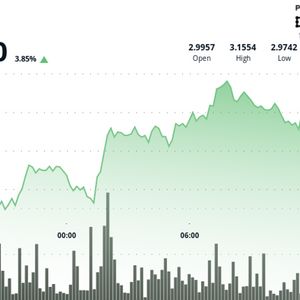Stablecoin Wars Intensify as Tether Grows and Fed Faces Scrutiny
7 min read
The stablecoin market continues to evolve rapidly, with Tether solidifying its lead despite growing competition and rising scrutiny from policymakers. A new report by Nansen shows that Tether’s USDt commands around 66% of the stablecoin market, significantly ahead of its rivals. At the same time, regulatory tensions are flaring, with Custodia Bank CEO Caitlin Long criticizing the US Federal Reserve for maintaining policies that favor stablecoins issued by major financial institutions. Long and other crypto advocates are now calling on Congress to pass legislation to create a more even playing field for the industry. Tether Maintains Commanding Lead in Stablecoin Market Amid Rising Competition Despite the rapid emergence of new players in the stablecoin ecosystem, Tether’s USDt remains the undisputed leader, commanding the lion’s share of the US dollar-pegged stablecoin market. A new report published by Web3 research firm Nansen on April 25 highlights the resilience of Tether’s dominance even as competitors like Circle’s USDC and Ethena’s USDe ramp up their efforts to close the gap. According to Nansen’s data, Tether (USDT) holds a commanding 66% share of the stablecoin market, significantly outpacing USDC , which accounts for around 28%. Ethena’s USDe stablecoin, despite its rapid rise in recent months, trails far behind with just over 2% of the total market. Tether has 66% of stablecoin market share (Source: Nansen) The data sheds light on a key point: even as new entrants innovate and offer different incentives, liquidity and user trust remain the ultimate determinants of success in the stablecoin sector. Nansen anticipates that, in a dynamic where users overwhelmingly gravitate toward the most liquid and perceived safest options, the stablecoin market will likely continue to operate under a ”winner-takes-most” paradigm. The report also highlights Tether’s remarkable profitability, which further cements its market leadership. In 2024 alone, Tether is estimated to have earned nearly $14 billion in profits. Tether generates revenue by accepting dollars in exchange for newly minted USDT and investing the underlying reserves into highly liquid, interest-bearing assets such as US Treasury bills. This strategy has allowed the company to capitalize on higher interest rates and market demand without significantly altering the fundamental trust model behind the stablecoin. Nansen noted that users are prioritizing liquidity and perceived safety over potential returns. “Given the growth of USDT and USDC, the users are clearly expressing that they do not necessarily care about the yield — they are forgoing it to Tether and Circle — they simply want access to the most liquid and least-likely-to-depeg stablecoin out there,” the firm said. Competitive Landscape: USDC’s Accelerated Growth and New Entrants While Tether continues to dominate, Circle’s USDC has seen an uptick in adoption since November 2024, coinciding with US President Donald Trump’s election victory. The renewed political climate has brought a more favorable regulatory environment for crypto in the United States, boosting institutional confidence in Circle’s US-regulated offering. USDC has seen faster growth than USDT since November (Source: Nansen) USDC’s transparency and regulatory status have made it particularly attractive to financial institutions that demand compliance clarity. However, competition in the sector is heating up fast, with major traditional finance players like Fidelity, PayPal, and several banking institutions making strategic moves into the stablecoin space. Notably, payment giant Stripe recently announced plans to create a new stablecoin product, leveraging its 2024 acquisition of Bridge, a stablecoin platform. Meanwhile, PayPal’s PYUSD and Ripple USD are steadily gaining traction among retail and institutional users alike. Nansen’s analysis suggests that although USDC has been growing faster than USDT in recent months, the sheer scale and liquidity of Tether will likely maintain its first-mover advantage for the foreseeable future. Among the new generation of stablecoins , Ethena’s USDe stands out for its unique value proposition. Since launching in early 2024, USDe has offered users an average annualized yield of about 19%, according to Ethena’s website. This yield-bearing structure has proven attractive, particularly in the decentralized finance (DeFi) sector and on centralized exchanges (CEXs) where users seek higher returns. While its current market share remains modest, Ethena’s strategic integrations and compelling yield profile position it as a formidable competitor moving forward. Still, the path to challenging Tether’s dominance remains steep, given the network effects and trust that established players enjoy. Outlook: A “Winner-Takes-Most” Future Nansen’s report concludes with a sober reflection: even as competition broadens and innovation flourishes, the stablecoin market is not likely to fragment evenly across multiple players. Instead, liquidity, trust, and regulatory certainty will drive users to consolidate their activity around a few dominant issuers. For now, Tether remains the undisputed heavyweight, leveraging its scale, profitability, and liquidity advantages to maintain a massive lead. However, the rapid acceleration of USDC, the expansion plans of traditional financial institutions, and the emergence of novel offerings like USDe indicate that the stablecoin battleground is far from static. In the coming months and years, market watchers will be keenly observing whether Tether can defend its dominance — or whether a changing regulatory environment and technological innovation will finally tilt the balance in favor of its fast-rising competitors. Caitlin Long Blasts Federal Reserve for Favoring Big-Bank Stablecoins, Urges Swift Congressional Action In other stablecoin news, Custodia Bank CEO Caitlin Long has sharply criticized the US Federal Reserve for quietly maintaining an anti-crypto policy that favors stablecoins issued by major financial institutions, despite recent moves to relax certain crypto partnership guidelines for banks. In a detailed thread posted to X on April 27, Long accused the Fed of ”regulatory favoritism” that could tip the balance of the emerging stablecoin market toward big banks at the expense of innovation and competition. While the Federal Reserve’s recent policy update rescinded four prior guidelines that restricted crypto partnerships, Long pointed out that a critical Jan. 27, 2023, policy statement — issued in coordination with the Biden administration — remains firmly in place. That statement effectively blocks banks from issuing stablecoins on permissionless blockchains and from engaging directly with crypto assets like Bitcoin, Ethereum, or Solana. “THE FED HAS MAINTAINED A REGULATORY PREFERENCE FOR PERMISSIONED STABLECOINS (ie, big-bank versions),” Long emphasized. She warned that this entrenched preference gives traditional financial institutions a ”head start” in the race to launch private stablecoins, while independent innovators and startups are forced to wait for comprehensive federal stablecoin legislation to pass through Congress. Calls for Swift Legislative Action Long’s criticism was not limited to the Federal Reserve; she also called on Congress to expedite its efforts to enact a federal stablecoin bill. “Congress should hurry up,” Long urged, arguing that new legislation could override the Federal Reserve’s restrictive stance and level the playing field for non-bank stablecoin issuers. The fate of the US stablecoin market has become a pressing issue in Washington, D.C., with several competing proposals seeking to regulate how stablecoins are issued, backed, and supervised. While a consensus has yet to emerge, the stakes are growing as financial giants like Fidelity, PayPal, and Stripe move into the sector. Beyond stablecoins, Long highlighted several operational challenges the Fed’s policy creates for banks attempting to engage with digital assets. Under current rules, banks are prohibited from acting as principals in crypto markets, which prevents them from market-making in major cryptocurrencies such as Bitcoin (BTC), Ether (ETH), and Solana (SOL). Additionally, she flagged a significant hurdle for banks offering crypto custody services: covering gas fees for on-chain transactions. While such fees are an essential and standard practice for custodians handling blockchain transactions, the Federal Reserve’s rules currently restrict banks from facilitating these payments, effectively hamstringing their ability to compete with non-bank crypto custodians. Summarizing her concerns, Long said the Fed’s actions are deliberately keeping “sand in the wheels” of banks entering the crypto custody and asset management sectors, while at the same time pushing permissioned stablecoins backed by established financial institutions to the forefront. In a scathing remark on the public messaging around the Fed’s recent announcement, Long said, “The Fed definitely won on PR spin — its press release listed a long list of guidance it rescinded but omitted ANY mention of the guidance it kept. That duped a lot of smart people, understandably.” Political Reactions: Senator Lummis and Industry Leaders Respond Long’s comments found support among prominent crypto advocates on Capitol Hill. Senator Cynthia Lummis, a longtime champion for digital asset innovation, blasted the Fed’s maneuver as little more than “lip service.” Lummis specifically cited Section 9(13) of the existing Fed policy, which categorizes Bitcoin and other digital assets as “unsafe and unsound” — a section that remains unrescinded. “The Fed is saying one thing and doing another,” Lummis remarked, signaling potential legislative action to counterbalance the Fed’s lingering anti-crypto stance. However, reactions across the broader crypto industry were mixed. Some, like Michael Saylor of Strategy, interpreted the Fed’s policy rollback as a step in the right direction. In an April 25 X post, Saylor said the changes mean that “banks are now free to begin supporting Bitcoin,” reflecting a cautiously optimistic view that regulatory barriers are gradually being lowered, even if unevenly. The debate over the Federal Reserve’s role in shaping the future of crypto banking is unlikely to abate soon. The current regulatory environment reflects a deep and growing divide between financial institutions pushing for clearer, innovation-friendly rules and regulators who remain wary of systemic risks posed by digital assets. As Congress deliberates on stablecoin legislation, and as more traditional financial institutions prepare to roll out blockchain-based products, the future landscape of stablecoins and crypto banking remains in flux. For Caitlin Long and other crypto advocates, the message is clear: without swift and decisive action from Congress, the Fed’s quiet preference for permissioned stablecoins could solidify the dominance of big banks in a sector that was once envisioned as an open, decentralized alternative to traditional finance.

Source: Coinpaper



